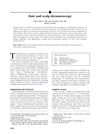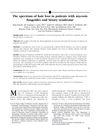TLDR Alopecia is caused by hormones, microorganisms, and immune issues.
The document discusses the increasing prevalence of alopecia in China and its impact on individuals' daily life and mental health. It highlights the multifactorial etiology of alopecia, including genetic, environmental, and disease-related factors, and the lack of comprehensive research on its specific causes. The article reviews several common types of alopecia, such as androgenetic alopecia, alopecia areata, frontal fibrosing alopecia, and seborrheic dermatitis, to clarify their specific causes and interrelationships. It proposes three biological indicators for triggering alopecia: hormones, microorganisms, and immune dysregulation, which could aid in the diagnosis and treatment of alopecia.
 245 citations
,
March 2012 in “Journal of The American Academy of Dermatology”
245 citations
,
March 2012 in “Journal of The American Academy of Dermatology” Dermatoscopy is useful for identifying different hair and scalp conditions and can reduce the need for biopsies.
 1 citations
,
July 2018 in “Elsevier eBooks”
1 citations
,
July 2018 in “Elsevier eBooks” Triple horizontal scalp biopsies are 98% accurate in diagnosing hair loss, better than single biopsies.
 69 citations
,
August 2014 in “Journal of The American Academy of Dermatology”
69 citations
,
August 2014 in “Journal of The American Academy of Dermatology” Trichoscopy is a quick, cost-effective tool for diagnosing different hair loss conditions.
 95 citations
,
November 2016 in “Journal of The American Academy of Dermatology”
95 citations
,
November 2016 in “Journal of The American Academy of Dermatology” Treatments for permanent hair loss from scarring aim to stop further loss, not regrow hair, and vary by condition, with partial success common.
 5 citations
,
October 2012 in “Expert Review of Dermatology”
5 citations
,
October 2012 in “Expert Review of Dermatology” Trichoscopy is a useful tool for diagnosing hair and scalp diseases without needing skin biopsies.
 39 citations
,
October 2010 in “Journal of The American Academy of Dermatology”
39 citations
,
October 2010 in “Journal of The American Academy of Dermatology” Some patients with mycosis fungoides or Sézary syndrome experience hair loss, which may be similar to alopecia areata or linked to skin lesions, possibly due to abnormal T cells, and bexarotene can help treat it.







